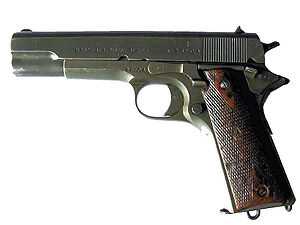Kongsberg Colt
| 11.25 m/m AUT. PISTOL M/1914, Kongsberg Colten. | |
|---|---|
 | |
| Type | Pistol |
| Place of origin |
|
| Service history | |
| Used by | Users |
| Wars | World War II |
| Production history | |
| Number built | 32,874[1] |
| Specifications | |
| Cartridge | 11.43x23mm ACP (.45 ACP) |
| Caliber | .45 |
| Action | Recoil-operated, closed bolt |
| Rate of fire | Semi-automatic |
| Muzzle velocity | 800 ft/s (244 m/s) |
| Feed system | 7 rounds (standard-capacity magazine), +1 in chamber |
The Kongsberg Colt is a nickname used for Colt M1911 pistols produced under license by the Norwegian factory Kongsberg Vaapenfabrikk.
History
Norway adopted the 7.5 mm Nagant revolver (named M/1893) as the standard Norwegian military sidearm in 1893. Commissions to test possible new service pistols were active from 1904 till 1911. In 1911, a commission recommended adoption of the semi-automatic .38 ACP caliber Colt Military Model 1902 pistol, after field trials with 25 such pistols, all purchased from Colt's London Agency. However, as the US had just adopted the Colt .45ACP M/1911 pistol it was decided to conduct further tests. A pistol of the new M/1911 design was received in Norway in January 1913. Following extensive tests through early 1914, if was finally decided, in August 1914, to adopt the Colt M/1911 pistol in Norway. These pistols were to replace the Nagant revolvers (7,5mm M/1893) as the standard military sidearm in Norway. Fabrique Nationale in Belgium signed a contract allowing Norway to manufacture the M1911 in September 1914. The pistol would be produced at Kongsberg Vaapenfabrikk in Norway.[1]
Production
As production start was slow, some M1911's were bought from Colt USA. 400 pistols were shipped to Norway for the Royal Norwegian Navy in 1915, 300 more pistols were shipped in 1917 for the Norwegian Army. Price was US$18.50 per piece.
The production at Kongsberg Våpenfabrikk in Norway started in 1916 and 95 pistols were finished in 1917 and wrongly stamped "COLT AUT. PISTOL M/1912" These pistols were identical to the Colt M1911 except for a minor detail on the hammer checkering. 100 pistols were ordered, but 5 were rejected during production. The serial range was from 1 to 95. Number 1 is in Bady's book "Government Models" and number 2 was stolen from Norwegian Armed Forces Museum in 1978.
Kongsberg Våpenfabrikk was ready to start mass production in 1918. One significant change was now made. The slide-stop was extended down and back to make it easier to operate. This change required a cut-out in the left stock. This change had been suggested in 1916, but did not materialize on the production pistols before in 1918. The new version had the left side of the slide stamped "11.25 m/m AUT. PISTOL M/1914." (AUT.= Automatisk) that was correct as the adoption of the gun was in 1914. Most of the pistols that had been marked "1912" were recalled to the factory to have the "new" slide stop installed. Production went on, but from 1932 to 1939 the production was very low, only 871 were made (approx 22,300 pieces were made before 1940).
During the German occupation of Norway (1940–1945), manufacture of the pistol, given the designation Pistole 657(n),[2] was continued under German control. The Waffenamt acceptance mark (WaA84) was added in 1945 and only those 920 pistols produced that year were ever Waffenamt-marked. It's not likely that any of these Waffenamt-marked pistols ever saw any action during World War II as the first one, serial# 29615, was delivered March 29, 1945 and the last one, serial# 30534, was delivered on 5 May 1945 just before liberation of Norway. In total, approximately 8200 pistols were made during German occupation (serials 22312-30534). All of them were delivered to AOK Norwegen (Army) except 700 that were delivered to Maza Norwegen (Navy).
Occupation production:
- 1940 = approx. 50 pistols
- 1941 = approx. 4099 pistols
- 1942 = 3154 pistols
- 1945 = 920 pistols
No pistols were produced in 1943 & 1944. In those years, production of Krag-Jørgensen rifles was prioritized.
A few pistols were assembled from existing parts after the war until production was halted at serial number 32854 in 1947. Twenty additional pistols were assembled from foreign-produced parts in 1987 as collector's pieces for the US market. A US dealer supplied commercial frames, slides and barrels as well as other parts that were assembled at Kongsberg. Previous markings were removed and Kongsberg markings and serials were engraved on the parts before the assembled pistols were returned to the US.[1]
Fakes
Some fakes have appeared. 1945 models produced after the end of World War II have been marked with fake Waffenamt marks. They are easily discovered, as serial numbers are higher than the last pistol made for the Germans (serial# 30534). Any pistol with year 1940/41/42 with WaA84 or any other Waffenamt markings are fakes and have been marked post-World War II.
Rare
Some of the most rare are the "Matpakke-Colt" (lunch box Colt) that were made out of parts smuggled out during World War II by workers and used by resistance forces. These have usually no serial markings or acceptance marks and the finish is usually not completed. The Waffenamt marked pistols are also very popular, 920 were made in 1945. The most rare are the first 95 marked with 1912.
Users
See also
Notes
- ↑ 1.0 1.1 1.2 Schreier, Philip American Rifleman (october 2008) p.124
- ↑ Axis History Factbook: Fremden Gerät: Captured Small Arms
Bibliography
- Kongsberg-Colten by Karl Egil Hanevik, 2003 1st edition, 400 pages, illustrated, Norwegian, ISBN 82-993143-2-1
External links
- Kongsberg Coltens venner Friends of Kongsberg Colten (Norwegian)